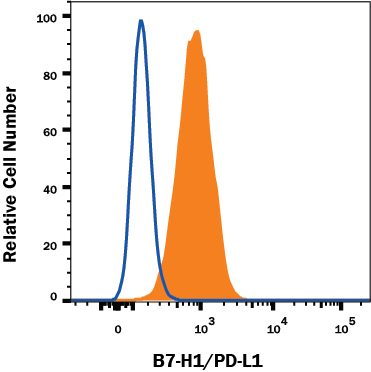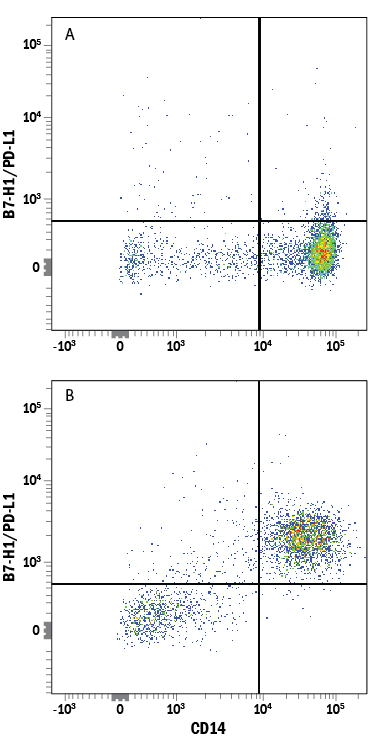Human PD-L1/B7-H1 APC-conjugated Antibody Summary
-H4, rhPD-L2, recombinant mouse B7-H1, recombinant rat (rr) B7-1, or rrB7-2 is observed.
Phe19-Thr239
Accession # Q9NZQ7
Applications
Please Note: Optimal dilutions should be determined by each laboratory for each application. General Protocols are available in the Technical Information section on our website.
Scientific Data
 View Larger
View Larger
Detection of PD-L1/B7-H1 in MDA-MB-231 Human Cell Line by Flow Cytometry. MDA-MB-231 human breast adenocarcinoma cell line was stained with Mouse Anti-Human PD-L1/B7-H1 APC-conjugated Monoclonal Antibody (Catalog # FAB1561A, filled histogram) or isotype control antibody (Catalog # IC002A, open histogram). Adherent cells were prepared by either manual scraping or with TrypLE Express treatment with similar results. View our protocol for Staining Membrane-associated Proteins.
 View Larger
View Larger
Detection of B7-H1/PD-L1 in Human PBMCs by Flow Cytometry. Human peripheral blood mononuclear cells (PBMCs) (A) resting or (B) treated with 1 µg/mL LPS overnight were stained with Mouse Anti-Human CD14 PE-conjugated Monoclonal Antibody (Catalog # FAB3832P) and Mouse Anti-Human B7-H1/PD-L1 APC-conjugated Monoclonal Antibody (Catalog # FAB1561A). Quadrant markers were set based on control antibody staining (Catalog # IC002A). View our protocol for Staining Membrane-associated Proteins.
Reconstitution Calculator
Preparation and Storage
- 12 months from date of receipt, 2 to 8 °C as supplied.
Background: PD-L1/B7-H1
Human B7 homolog 1 (B7-H1), also called programmed death ligand 1 (PD-L1) and programmed cell death 1 ligand 1 (PDCD1L1), is a member of the growing B7 family of immune proteins that provide signals for both stimulating and inhibiting T cell activation. Other family members include B7-1, B7-2, B7-H2, PDL2 and B7-H3. B7 proteins are members of the immunoglobulin (Ig) superfamily. Their extracellular domains contain 2 Ig-like domains and all members have short cytoplasmic domains. Among the family members, there is about 20-25% amino acid identity. Human and mouse B7-H1 share approximately 70% amino acid sequence identity. B7-H1 has been identified as one of two ligands for programmed death-1 (PD-1), a member of the CD28 family of immunoreceptors. The B7-H1 gene encodes a 291 amino acid (aa) type I membrane precursor protein with a putative 18 aa signal peptide, a 220 aa extracellular domain, a 21 aa transmembrane region, and a 31 aa cytoplasmic domain. Human B7-H1 is constitutively expressed in several organs such as heart, skeletal muscle, placenta and lung, and in lower amounts in thymus, spleen, kidney and liver. B7-H1 expression is upregulated in a small fraction of activated T and B cells and a much larger fraction of activated monocytes. B7-H1 expression is also induced in dendritic cells and keratinocytes after IFN-gamma stimulation. Interaction of B7-H1 with PD-1 results in inhibition of TCR-mediated proliferation and cytokine production. The B7-H1:PD-1 pathway is involved in the negative regulation of some immune responses and may play an important role in the regulation of peripheral tolerance.
- Nishimura, H. and T. Honjo (2001) Trends Immunol. 22:265.
- Freeman, G.J. et al. (2000) J. Exp. Med. 192:1027.
- Latchman, Y. et al. (2001) Nat. Immunol. 2:261.
Product Datasheets
FAQs
No product specific FAQs exist for this product, however you may
View all Antibody FAQsReviews for Human PD-L1/B7-H1 APC-conjugated Antibody
There are currently no reviews for this product. Be the first to review Human PD-L1/B7-H1 APC-conjugated Antibody and earn rewards!
Have you used Human PD-L1/B7-H1 APC-conjugated Antibody?
Submit a review and receive an Amazon gift card.
$25/€18/£15/$25CAN/¥75 Yuan/¥2500 Yen for a review with an image
$10/€7/£6/$10 CAD/¥70 Yuan/¥1110 Yen for a review without an image

